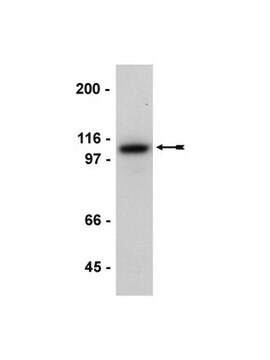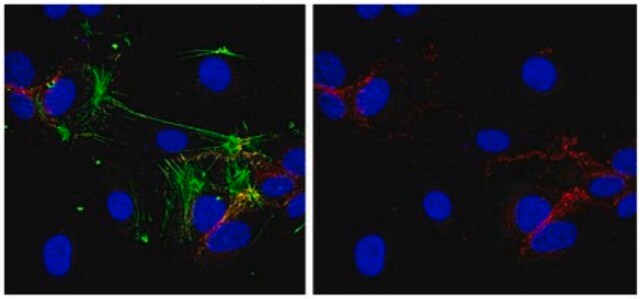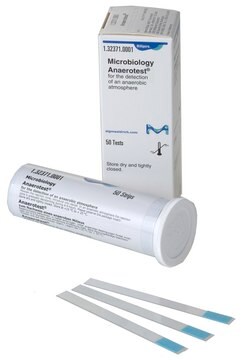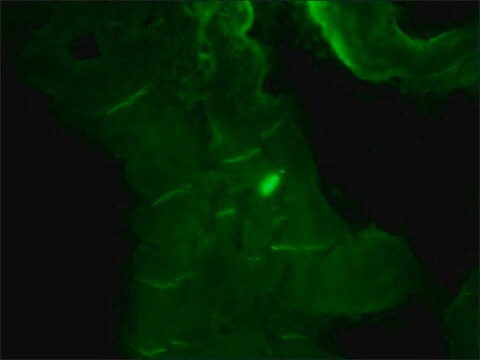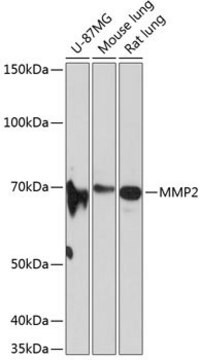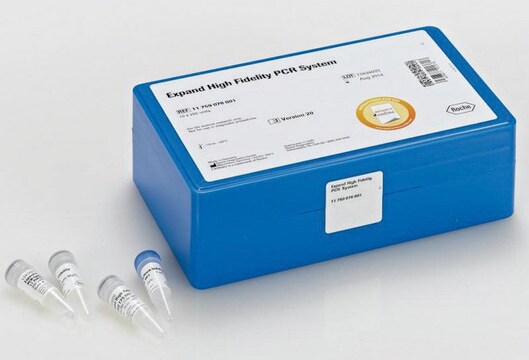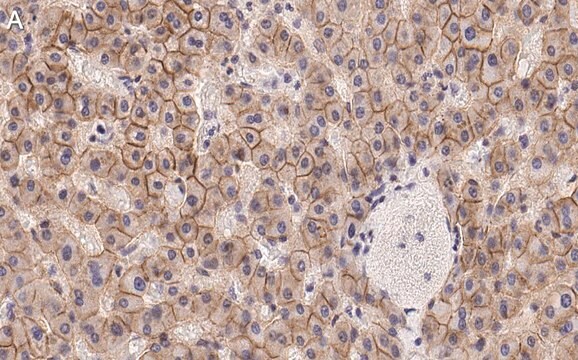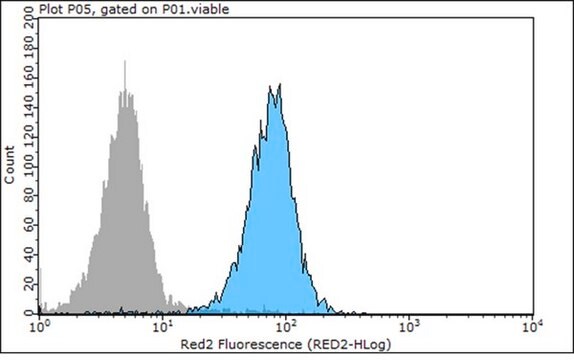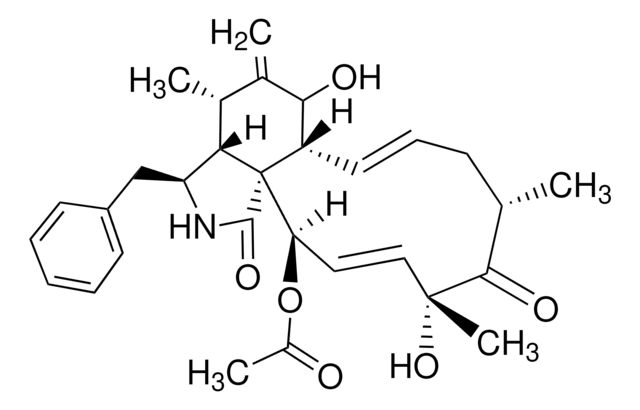05-915
Przeciwciało przeciwko N-kadherynie, klon 13A9
culture supernatant, clone 13A9, Upstate®
Synonim(y):
Kadheryna-2, CD325, CDw325, N-kadheryna, kadheryna neuronalna
About This Item
Polecane produkty
pochodzenie biologiczne
mouse
Poziom jakości
forma przeciwciała
culture supernatant
rodzaj przeciwciała
primary antibodies
klon
13A9, monoclonal
reaktywność gatunkowa
human
opakowanie
antibody small pack of 25 μL
producent / nazwa handlowa
Upstate®
metody
immunocytochemistry: suitable
immunohistochemistry: suitable
immunoprecipitation (IP): suitable
western blot: suitable
numer dostępu NCBI
numer dostępu UniProt
Warunki transportu
ambient
docelowa modyfikacja potranslacyjna
unmodified
informacje o genach
human ... CDH2(1000)
Powiązane kategorie
Opis ogólny
Specyficzność
Immunogen
Zastosowanie
Analiza immunohistochemiczna: Reprezentatywna partia wykryła silną immunoreaktywność N-kadheryny w parafinowych tkankach raka odbytnicy (RC) z dodatnim statusem przerzutów do regionalnych węzłów chłonnych (RLNM), podczas gdy tylko słaba immunoreaktywność N-kadheryny została wykryta w RC z ujemnym RLNM, a nie zaobserwowano barwienia N-kadheryny w prawidłowym nabłonku jelita grubego (Fan, X.J., et al. (2012). Br. J. Cancer. 106(11):1735-1741).
Analiza immunohistochemiczna: Reprezentatywna partia wykryła immunoreaktywność N-kadheryny w utrwalonych w formalinie, zatopionych w parafinie skrawkach tkanki raka wątrobowokomórkowego (HCC). Stwierdzono istotną odwrotną korelację między poziomami ekspresji RUNX3 i N-kadheryny (Tanaka, S., et al. (2012). Int. J. Cancer. 131(11):2537-2546).
Analiza Western Blotting: Reprezentatywna partia wykryła zwiększoną ekspresję N-kadheryny w komórkach raka CCL185 po przejściowej infekcji wirusem Epsteina-Barr (EBV). Fenotyp podobny do EMT utrzymywał się nawet po utracie wirusa w wyniku wycofania ciśnienia selekcji hodowli (Queen, K.J., et al. (2013). Int. J. Cancer. 132(9):2076-2086).
Analiza Western Blotting: Reprezentatywna partia wykryła N-kadherynę w lizatach komórek ludzkiego raka wątrobowokomórkowego (HCC) Hep3B, Huh7, HLF i SK-Hep1 (Tanaka, S., et al. (2012). Int. J. Cancer. 131(11):2537-2546).
Analiza Western Blotting: Reprezentatywna partia wykryła zarówno nieprzetworzoną (pro-), jak i przetworzoną (dojrzałą) formę N-kadheryny w lizacie komórek HeLa (Wahl, J.K. 3rd., et al. (2003). J. Biol. Chem. 278(19):17269-17276).
Analiza Western Blotting: Reprezentatywna partia wykryła N-kadherynę w lizacie ludzkich fibroblastów WI-38, ale nie w lizacie ludzkich komórek raka kosmówki łożyska JAr (Knudsen, K.A., et al. (1995). J. Cell Biol. 130(1):67-77).
Analiza immunocytochemiczna: Reprezentatywna partia wykryła immunoreaktywność N-kadheryny zlokalizowaną głównie na granicach komórka-komórka za pomocą fluorescencyjnego barwienia immunocytochemicznego 1% utrwalonych paraformaldehydem, przepuszczalnych dla metanolu komórek HeLa (Wahl, J.K. 3rd., et al. (2003). J. Biol. Chem. 278(19):17269-17276).
Analiza immunocytochemiczna: Reprezentatywna partia wykryła immunoreaktywność N-kadheryny kolokalizowaną z immunoreaktywnością alfa- i beta-kateniny poprzez podwójne fluorescencyjne barwienie immunocytochemiczne utrwalonych ludzkich fibroblastów WI-38 (Knudsen, K.A., et al. (1995). J. Cell Biol. 130(1):67-77).
Analiza immunoprecypitacji: Reprezentatywne partie koimmunoprecypitowały alfa-kateninę, beta-kateninę i plakoglobinę z N-kadheryną z lizatów ludzkich fibroblastów WI-38 i komórek HeLa (Wahl, J.K. 3rd., et al. (2003). J. Biol. Chem. 278(19):17269-17276; Knudsen, K.A., et al. (1995). J. Cell Biol. 130(1):67-77).
Struktura komórki
Adhezja (CAMs)
Jakość
Western Blotting Analysis: A 1:1000-5000 dilution of this hybridoma culture supernatant detected N-cadherin in HeLa cell lysate.
Opis wartości docelowych
Powiązanie
Postać fizyczna
Przechowywanie i stabilność
Komentarz do analizy
Lizat komórek HeLa
Informacje prawne
Oświadczenie o zrzeczeniu się odpowiedzialności
Nie możesz znaleźć właściwego produktu?
Wypróbuj nasz Narzędzie selektora produktów.
polecane
Certyfikaty analizy (CoA)
Poszukaj Certyfikaty analizy (CoA), wpisując numer partii/serii produktów. Numery serii i partii można znaleźć na etykiecie produktu po słowach „seria” lub „partia”.
Masz już ten produkt?
Dokumenty związane z niedawno zakupionymi produktami zostały zamieszczone w Bibliotece dokumentów.
Produkty
Human iPSC neural differentiation media and protocols used to generate neural stem cells, neurons and glial cell types.
Podłoża do różnicowania neuronalnego ludzkich iPSC i protokoły stosowane do generowania neuronalnych komórek macierzystych, neuronów i komórek glejowych.
Nasz zespół naukowców ma doświadczenie we wszystkich obszarach badań, w tym w naukach przyrodniczych, materiałoznawstwie, syntezie chemicznej, chromatografii, analityce i wielu innych dziedzinach.
Skontaktuj się z zespołem ds. pomocy technicznej